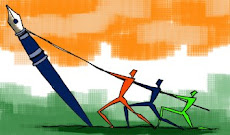Bhumi's members Sai and Pallavi (one of CSIMs students too!) greeted us and gave an outline of their flagship Dhronacharya and Ekalavya program (DNE) in which Bhumi trains and deploys volunteers to mentor the school children on a weekly basis on academics and extra-curricular activities. The program seems to spring from the notion that kids in the slum study better when they are exposed to an "elder-brother-cum-role model" who can inspire and provide them a regular learning environment.
Abdul Mujib Khan, one of the founding members of Bhumi, provided a brief account of their history. Rasoolpura, like any other urban slum, faced multiple interlinked problems. Poverty resulting in child labour, in turn resulting in low academic performance and high dropouts. Poor conditions resulting in poor health problems, in turn resulting in loss of wage which compounds the problem of child labour and education. Further, the cynicism of the slum dwellers towards the "outsiders in Proline T-shirts" posed another layer challenge.
To address the first problem, Bhumi has divided its task in Rasoolpura into four domains viz., Livelihood, Education, Healthcare and Water & Sanitation. Then it adopted the then dilapidated Govt. High school. and with funding from Sarva Shikhsa Abhiyan and Hyderabad Round table, they renovated the school, hired teachers and got the school back up and running. This automatically helped Bhumi address the second problem too as the promise kept acted as a good testimony to their commitment to area. With more kids in school on a regular basis, the DNE program was launched in an effort to improve the pass percentage (then a dismal 13%) among 10th std kids. To improve the livelihood, Bhumi used the trust built to constitute about 6 self-help groups among the womenfolk (headed by a slum-dweller named Razia).
A crucial aspect that needs addressing in improving this society, they said, is the mentality slum-dwellers towards the SHG in general and using the loaned money in particular. As expected, the primary modes of income to people in the slum are fruit and vegetable hawking, house-help, working as a driver or running an autorickshaw. Since the livelihood is always hand-to-mouth, the mentality to save and planning for the longer term was lacking and took repeated counselling to attain a decent awareness level present now. Further, when Razia tried to spread the idea of forming a "group" the first question they usually asked was "How much money will I get?".
Bhumi is also involved in improving the other dimensions of the problem that affects education. Health. One school of thought suggests that children brought up with inadequate nutrition till the age of 5 show learning disabilities that affect them for the rest of their life. They took the initiative to bring in some students of medicine to conduct "Bailey's test" and found that about 20% of them fail the test. However, since medical treatment needs to be sustained over a long term for improvement, it is challenging to keep the respective families interested.
With the slum-dwellers increasingly placing their trust on them, Bhumi is also working on slowly training and transfering the control of their initiatives to the local slum-dwellers, though this seems to be a long objective.
A few other takeaways from the field visit
- Their initiatives, especially with respect to education, are modeled in such a way that it can be "sold" to the government to adopt as an accepted model of education (am a bit confused about this, asked for clarification, will update!)
- Bhumi seems to have extensively used the help of CSIM, who I have found myself are larger directory of contacts than "YellowPages" if you are a social entrepreneur. They have also helped Bhumi is redesigning their DNE mentoring program.
- Most of their successful initiatives have been field tested on a smaller scale (say, applied to a smalller section of the slum) and then have been scaled up. Probably a good point to remember.










